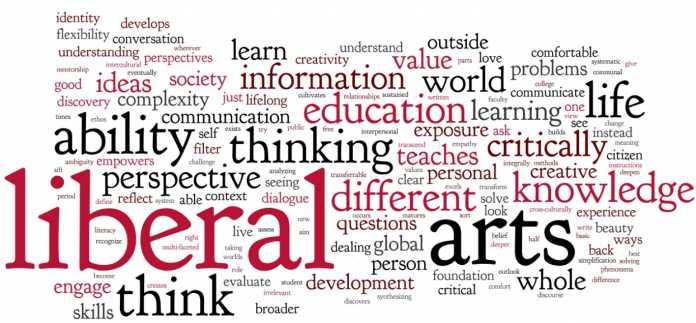A Liberal Arts course is an interdisciplinary study encompassing four main areas of study – humanities, social sciences, natural sciences, and formal sciences, which the aim of providing a much broader knowledge base and skill set. This will also apply to studying any one of the subjects in each of these areas.
Humanities includes art, literature, linguistics, philosophy, religion, ethics, modern foreign languages, music, theater, speech, classical languages (Latin/Greek) etc. Social sciences includes history, psychology, law, sociology, politics, gender studies, anthropology, economics, geography, business informatics, etc. Subjects under Natural sciences include astronomy, biology, chemistry, physics, botany, archaeology, zoology, geology, Earth sciences, etc. Mathematics, logic, statistics, etc. fall under formal sciences.
How it came about is that during the Greco-Roman era, when a liberal arts’ education was considered to be the ultimate mark of an educated person. Liberal arts covered only three subjects, i.e. grammar, rhetoric, and logic, also known as ‘Trivium’. However, it was considered a necessity for an individual in a civic life. An individual with a liberal arts education could participate in public debate, serve in court and on the jury, defend oneself, or even participate in the military. In medieval times, liberal arts was extended to include subjects such as music, astronomy, arithmetic and geometry.
The aim of this type of education was to produce a person who was virtuous and ethical, knowledgeable in many fields and highly articulate. Although the curriculum has gone through subsequent updates over the years, the core aim of the course has always been the very same – to develop well-rounded people with a much wider knowledge base and a vast range of skills.
There are a vast number of dedicated Liberal Arts’ colleges in the U.S, with degree that are earned in four-year, full time courses. The basic difference between normal university courses and liberal arts’ courses is that they mandate a high level of student participation, and student-teacher interactions and mentorship. The class size is much lower and personal student attention is more feasible.
Although its origins lie in Europe, there are far more liberal arts courses and colleges in the US than there are in Europe. It is said that less than half European colleges and universities offer courses. Although in India it is still an emerging area of study, a report says that many private universities in India plan to be more inclusive of the interdisciplinary model of study to help better its global standing. The report also says that in the future, jobs would depend more on interpersonal skills, reasoning skills, soft skills, and how can individuals stand out in the market and at their workplace rather than just on paper, which are all attributes of a liberal arts education.
A liberal arts degree holds great value in your career, as it will prepare you to work in a variety of sectors, and introduces you to a wide range of career choices, thus widening your career perspective. Graduates can find employment in academia, arts, political sciences, biology, marketing, research, law enforcement, and many more.
Top Universities with Liberal Arts’ Courses in the US –
- Amherst College
- Swarthmore College
- Middlebury College
- Wellesley College
- Haverford College
Top Indian Universities –
- Ashoka university, Delhi
- Madras Christian College, Chennai
- Azim Premji University, Bengaluru
- Flame University, Pune
- Apeejay Stya University, Gurgaon.






























